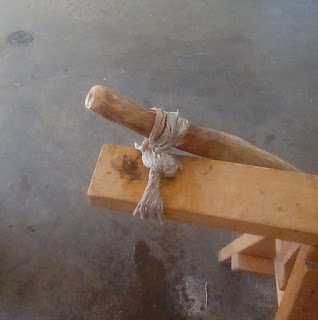The Titanium Kettle, Building An Efficient Fire to Cook, And Other Cooking Tips
Of all the items embraced following European colonization of North America, the metal cup seems the most indispensable. I have yet to find a natural replacement that matches utility of the metal cup. How else to rehydrate the body during winter without having to eat snow or drink from cold rivers is a mystery to me. Clay pots were used by pre colonial natives, but their fragility seems to make them impractical for winter hunters. One natove once said that her thought the king of France must have shown his weath by the many pots he must have owned.
The knife, gun, axe, can all be substituted, but to make a quick, tough, vessel to boil seems impossible.
Even during the summer, a cold cup of water can drain calories by making your body cold (dangerous if your calories are limited); a quick fire under a light titanium kettle can heat the water up to at least body temperature to avoid this.
While on this topic, skin or stomach cook pots may have never been used; maybe a special clay pit cook vessel, but not a vessel of wet animal protien; I've tried making one and it wont take heat and maintain integrity; animal protien cooks and becomes weak. However, a pot made from a thick, DRY, hide portion may work with a limmited life span. Further investigation is warranted.
Returning to the titanium pot...
The knife, gun, axe, can all be substituted, but to make a quick, tough, vessel to boil seems impossible.
Even during the summer, a cold cup of water can drain calories by making your body cold (dangerous if your calories are limited); a quick fire under a light titanium kettle can heat the water up to at least body temperature to avoid this.
The kettle is best used with a small fire. Dry low spruce twigs with a sleeve of birch under. Light the birch, and keep the small flame going by adding some pinky finger sized twigs when it gets low. If you need to get water, fill the kettle with clean river water or snow and put it over the small flame.
I use a titanium kettle, 1L for its light weight, strength, and, I think non metal leaching qualities; for the money, its worth the investment as you will find a long term reliable and light tool in it.
I use a titanium kettle, 1L for its light weight, strength, and, I think non metal leaching qualities; for the money, its worth the investment as you will find a long term reliable and light tool in it.
I have a 2L I have used to render a whole bear. The grease can be skimmed with the lid and stored (though a spoon may be better if one is on hand).
My 6L behemoth is my current camp workhorse. I simply fill it to the brim with snow and it melts to enough for a meals rehydration.
Having tried said sizes, I'd recomend to buy the biggest pot you can find and afford. The smallest is not that much lighter than the larger and you can carry stuff inside the pot while I the move. The larger pots are just far more versatile and useful than a small mug sized one
If your kettle is without a bail handle, and you prefer not to improvise one, I use a couple stones or clumps of hard clay to bring the fire beneath the pot. You will also want a third stone to an open end to act as wind break; this will focus the heat more to the underside of your mug; it will also consume less fuel as the liquid within the mug will heat far quicker.
You can add a simple bail handle to the rim of your kettle; this can be done with two simple, thin, iron wires so that drilling or punching with a nail is avoided; one bound tight around the kettle top and one, making the handle, connecting side to side through the one bound round the top.
The bail handle can easily be hung from an overhanging branch to heat on a fire.
I ended up punching the holes to eliminate the wire around the pot. To do this, simply punch the hole with a nail, then, when you need to hang the pot, add the wire through the hole. Punch the hole just low enough so the wire will not contact the lid when it is used.
Use a tuff of moss, sticks or a cloth stuffed inside the larger kettle if you want to eliminate rattling from another smaller pot which may be packed within.
The tar that develops under your pot from use on a fire can be easily cleaned by putting the kettle over the fire dry; this will ignite the tar and turn it to carbon where it can be scraped off.
If you use the three-stone-fire-pit to cook, (which is to find three large stones and place them together like you are making a small fire coral (small enough that your cook pot can bridge the two front stones) and buld a fire in the center), make sure you put the water on the front of the pit, at the open end; this will precariously position your pot on only two of the three stones, so make sure your pot is stable: the reason for this is that the fire will have air coming through in the back and front so it wont struggle to stay lit (which means less smoke and blowing), and the pot will stay well over the fire and thus heat far faster.
While cooking anything larger than a squirle, like a porcupine or beaver, chop into smaller pieces - I don't debone - before cooking to ensure a fast and thorough cook.


